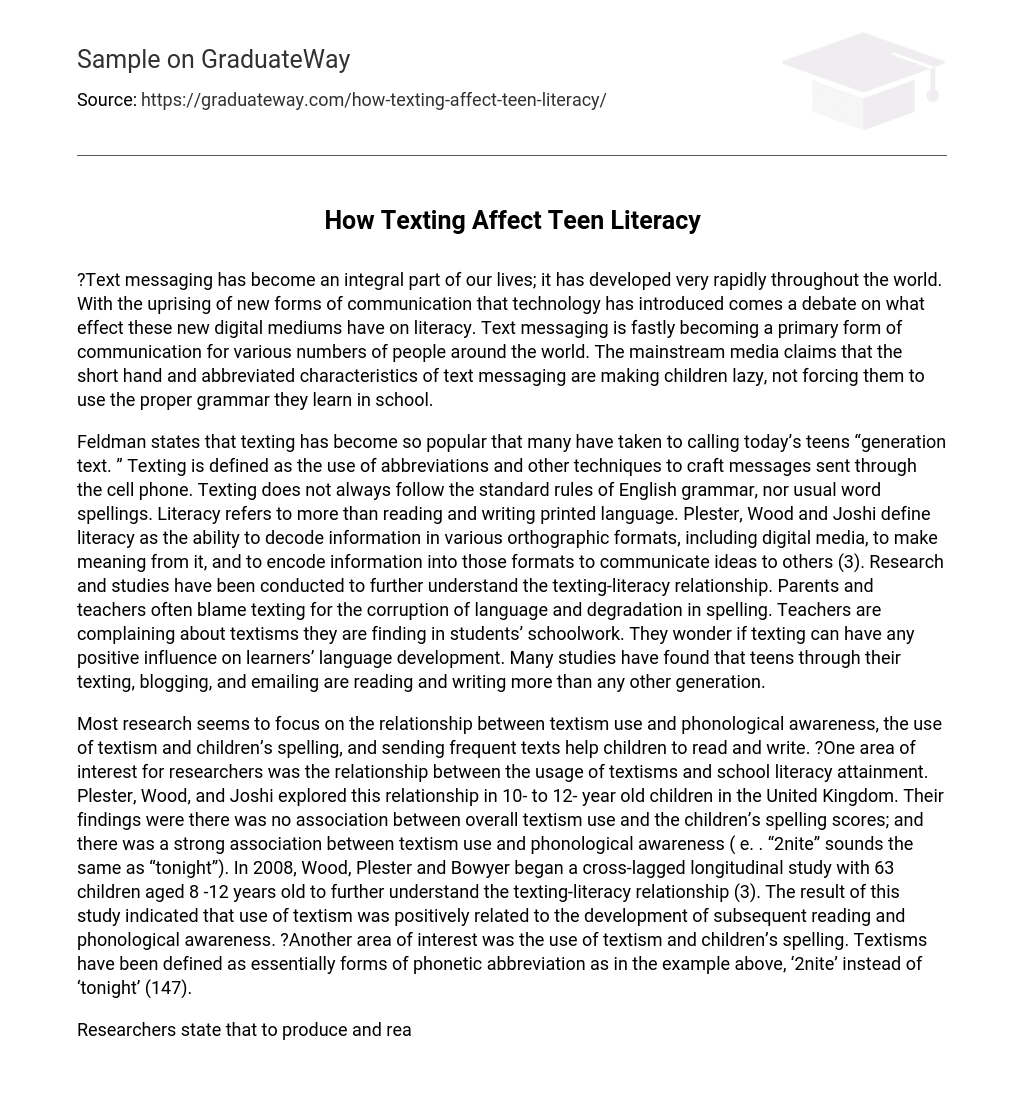Text messaging has rapidly become an integral part of our lives worldwide, sparking a debate on its impact on literacy. It is increasingly becoming the primary means of communication for many individuals. Critics argue that the shorthand and abbreviated nature of text messaging are making children lazy, as it discourages the use of proper grammar taught in schools.
Feldman states that texting has become so popular that many have taken to calling today’s teens “generation text.” Texting, the use of abbreviations and other techniques to craft messages sent through the cell phone, does not always adhere to the standard rules of English grammar or usual word spellings. According to Plester, Wood, and Joshi, literacy encompasses more than reading and writing printed language. It involves the ability to decode information in various orthographic formats, including digital media, to make meaning from it and encode information into those formats to communicate ideas to others (3). Research and studies have been conducted to gain a deeper understanding of the texting-literacy relationship. Parents and teachers often attribute the corruption of language and degradation in spelling to texting. Textisms found in students’ schoolwork lead teachers to question if texting has any positive impact on learners’ language development. However, many studies have discovered that teens engage in more reading and writing through activities like texting, blogging, and emailing compared to previous generations.
Most research focuses on the relationship between textism use and various aspects of children’s literacy. One area of interest is the relationship between textism use and school literacy attainment. Plester, Wood, and Joshi studied 10- to 12-year-old children in the UK and found no association between overall textism use and spelling scores, but a strong association between textism use and phonological awareness. In 2008, Wood, Plester, and Bowyer conducted a longitudinal study with 63 children aged 8-12 to further understand the texting-literacy relationship. The study found that textism use was positively related to subsequent reading and phonological awareness development. Another area of interest is the use of textism in children’s spelling. Textisms are defined as forms of phonetic abbreviation, such as ‘2nite’ for ‘tonight’.
According to researchers, the ability to produce and understand abbreviated text requires the child to have a certain level of phonological and orthographic awareness. Phonological awareness has been a key focus in reading research for many years, and these studies have consistently found a connection between various forms of phonological awareness and reading skills (147). A study was conducted to examine how text abbreviations relate to spelling abilities.
The text contained the following categories of textism: accent stylization (wiv, anuva), non-conventional spellings (fone, rite, skool), letter/number homophones (2moro, l8r), g-clippings (swimming, goin, comin), initialisms (lol, ttfn), contractions (txt, plz, hmwrk), and shortenings (bro, sis, tues) (151). The study found that having knowledge of textism was positively associated with spelling achievement, and that using the more phonologically based forms of textism explained the most variation in conventional spelling scores. Another area of interest for researchers was whether sending frequent texts helps children with reading and writing.
The use of text messaging is rapidly growing and replacing voice calls among 13 to 24-year-olds. This has led to the emergence of “text speak,” a new written vocabulary characterized by acronyms, emoticons, and the omission of unnecessary elements. Text speak resembles early stages of phonological spelling. Students find texting fun and see it as an opportunity to express their creativity through inventive and playful text styles. Plester, Wood, and Joshi highlight that these text styles are creative expressions of children’s engagement with language, and they are motivated to become literate in order to communicate rapidly and effectively with their peers.
Research indicates that teenagers have a preference for texting rather than talking when communicating with friends. This has led to discussions on the influence of texting on literacy skills. Nevertheless, studies indicate that texting does not negatively affect literacy abilities. Texting is extensively utilized by children, teenagers, and young adults as a way to interact with their peers. However, they are aware of using proper language when communicating with their educators. Texting provides them with an engaging and inventive method to express themselves comfortably, thus becoming a prevailing communication trend.





